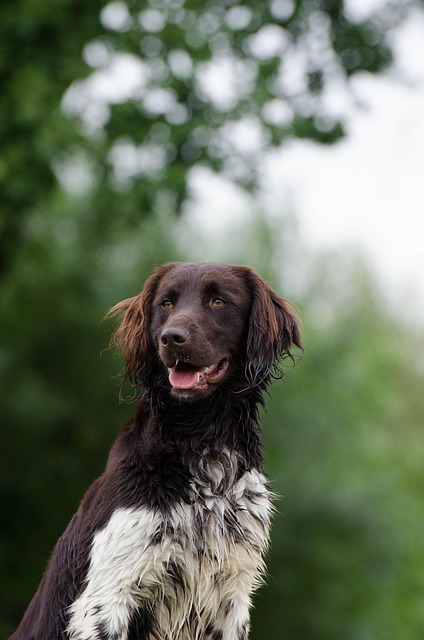


The Small Munsterlander Pointer is a medium-sized, versatile gundog breed known for its keen sense of smell, agility, and intelligence. This breed is primarily used for bird hunting, working as a pointing and retrieving dog in various terrains. The Small Munsterlander is affectionate, loyal, and generally friendly with people, making it a good family companion. Their energetic nature and strong hunting instinct mean they require plenty of exercise and stimulation to stay happy. This breed is known for being both independent and eager to please, making them an excellent choice for active owners who enjoy outdoor activities like hiking, running, or hunting.
The Small Munsterlander Pointer, also known as the Kleine Münsterländer, originates from the Münster region of Germany. It was developed in the 19th century by breeders who sought to create a versatile hunting dog capable of both pointing and retrieving game. The breed's ancestors include various spaniels and pointers, which contributed to its exceptional skills in bird hunting. The Small Munsterlander was primarily used in the field to locate and retrieve game birds, making it an invaluable tool for hunters. While the breed was relatively common in Germany and parts of Europe, it remained relatively unknown in the United States until more recently. The breed was officially recognized by the Federation Cynalogique Internationale (FCI) in 1985 and is increasingly recognized by organizations like the American Kennel Club (AKC) for its skills and temperament as a versatile sporting dog.
The Small Munsterlander Pointer has a well-balanced, athletic build. They typically stand between 18 to 21 inches tall at the shoulder and weigh between 35 to 50 pounds. This breed has a sleek, medium-length coat that is usually brown and white, with a combination of solid and patched markings. Their coat is water-resistant, which helps them work in various conditions, including wet and cold environments. They have long, floppy ears that are covered with a slightly wavy coat, and their eyes are dark and expressive. Their tail is moderately long and carried level or slightly upward, often wagging in excitement. The Small Munsterlander has a graceful and agile appearance, and their build reflects their ability to work as an efficient hunting dog in the field.
The Small Munsterlander Pointer is known for its friendly, affectionate, and eager-to-please personality. They are generally good-natured with both their family members and strangers, although early socialization is key to ensuring they are well-adjusted. Despite their friendly nature, they have an independent streak and can sometimes be stubborn, especially when it comes to hunting or following scents. This breed is intelligent and trainable but requires consistent leadership and positive reinforcement during training. Small Munsterlanders typically get along well with children and other pets when properly socialized. They are energetic, enthusiastic, and enjoy spending time with their families, especially if it involves outdoor activities like hiking, swimming, or running.
The Small Munsterlander Pointer is an energetic and active breed that requires regular exercise to maintain its health and well-being. As a working dog, they thrive in environments where they can run and explore, and they enjoy activities like hiking, running, swimming, and, of course, hunting. These dogs are best suited for active households or individuals who can provide them with plenty of outdoor time. Daily walks or jogs, along with opportunities for off-leash play in a secure area, are important for this breed. Because of their strong hunting instincts, they enjoy activities that challenge their tracking and retrieving skills. Mental stimulation through interactive toys or scent work also helps keep them content and prevents boredom. Without enough physical and mental exercise, Small Munsterlanders can become restless and potentially destructive.
The Small Munsterlander Pointer is an intelligent and trainable breed, but they can be independent and occasionally stubborn, particularly when their hunting instincts are triggered. Positive reinforcement methods, such as treats, praise, and play, work best with this breed. Consistency and patience are key during training, as they respond best to clear, positive guidance. Early socialization is important to help them become well-adjusted adults and to reduce the likelihood of behavioral problems. Exposing a Small Munsterlander to a variety of people, animals, and environments from a young age will help them develop a calm, balanced temperament. While they are generally good with children and other pets, supervision is necessary around smaller animals, as their strong prey drive can lead them to chase after smaller creatures.
The Small Munsterlander Pointer is generally a healthy breed, but like all dogs, they can be prone to certain health issues. Some common health concerns in Small Munsterlanders include hip dysplasia, elbow dysplasia, and progressive retinal atrophy (PRA), a condition that can lead to vision loss. Regular veterinary check-ups and early detection of any health problems can help manage these conditions effectively. Their coat requires regular grooming to prevent tangling, and brushing several times a week will help maintain its texture and health. The breed's long ears should be checked regularly for signs of infection, as they are prone to ear problems. Additionally, regular dental care and routine flea and tick prevention are essential to keep them healthy. Keeping them at a healthy weight and providing enough exercise can help avoid obesity-related health issues.
The average lifespan of a Small Munsterlander Pointer is around 12 to 14 years, with proper care. With regular veterinary visits, a balanced diet, and plenty of exercise, they can live a long, healthy life. Providing mental stimulation and physical activity throughout their lives can help ensure that they remain active and healthy into their senior years. As with any breed, monitoring for breed-specific health conditions and maintaining overall wellness can contribute to a longer, happier life.
© copyright Dog Compendium 2024 - 2025